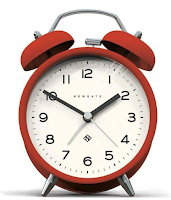It often amazes me that there is so much maths around us that we never see.
Is it because we are too focussed on the Curriculum/Syllabus or achievement outcomes?
Is it because we have been encouraged to use WALT's for each lesson?
Or is it because we are not really a child centred education system like we profess.
I recently posted about patterns in Calendars, and was amazed by the views the blog had. Today's blog is Clocks, especially the Analogue Style, that is of course the type I grew up with!
When I was teaching, in a previous lifetime, every classroom had an analogue-that's right, a round one! These days we see an abundance of digital clocks and watches but the good old Analogue is often forgotten. Due to this, I venture to say, the younger generation have difficulty telling the time from one as they prefer the digital! (I prefer an analogue face on my iWatch)
Call me old fashioned if you wish, but I believe there is a place for both and if I am honest I believe the Analogue allows for greater exploration than the digital.
I suggest to you that the analogue clock can help students "measure time" as well as "read time"! They can see how far the hands have moved and therefore can say its gone 5 minutes, 15 mins etc. The digital clock on the other hand is easy to "read time" but much harder to measure time as students have to remember the start time, the end time and then add or subtract etc!
Other Uses for the Analogue Clock include:
Fractions: show me a 1/4, 1/2, 3/4 etc and perhaps thirds, sixths and twelfths (of a turn)
Geometry: One complete turn (of a hand) creates a circle which is 360 degrees. Have the students stand and jump quarter, half, whole turns, then substitute 90 degrees, 180, 360, 270 etc. Once they know that there are 360 degrees in a turn they could work out the degrees in 5 minutes, 10 minutes etc. The Analogue Clock is a great way for students to realise that Degrees are the measure of turn, not a straight line measure
Problems: How many times in a day(12 or 24 hours) do the minute and hour hands of a clock form a 180 degree straight line?
How many times in a day do the minute and hour hands of a clock coincide(the angle between them is zero degrees)?
From: Nrich Can you draw a straight line across the centre of a clock face so that the numbers on both sides of the line have the same total? Can you do this a second way?
Can you draw two lines to divide a clock face so that the numbers on one side of the lines is twice the total on the other side? Can you do it another way?
Can you divide the clock face so that the total on one side of the lines is five times more than the total on the other side? Can you do this another way?
Can you draw two lines to divide the numbers so that the total of the numbers of each sideof the lines are both multiples of six? In how many ways can you do this?
Can you find any other interesting ways to group the numbers on a clock face by drawing two lines?
Maths Hidden in the Clock Face
What I find fascinating is the various number pairs that an analogue clock has! How many times, over the years, have you looked at the clock face read the time, and then moved on, never realising that these number pairs were there all the time!
Find all the pairs of numbers on an Analogue Clock that add to 12
Find all the pairs of numbers on an Analogue Clock that add to 13
Find all the pairs of numbers on an Analogue Clock that add to 11
Find all the pairs of numbers on an Analogue Clock that have a difference of 6
